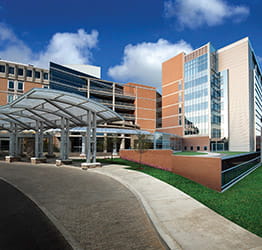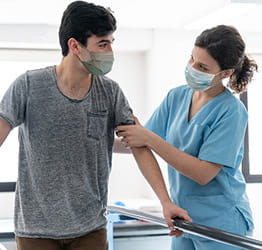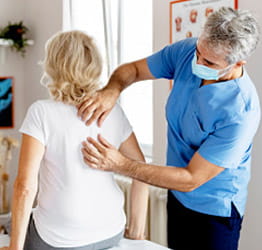On this page
What Is Sarcoidosis?
Sarcoidosis is an inflammatory condition that involves tiny clusters of immune system cells that form lumps in the body called granulomas. These red, swollen granulomas can occur anywhere in the body but are mostly found in the lungs, eyes, heart, skin, and lymph nodes in the chest.
Sarcoidosis can occur anytime your body’s immune system reacts to bacteria, chemicals, or viruses, quickly building clumps of cells or tissues in various organs.
If left untreated or if they don’t go away on their own, these tissues can cause permanent scarring or prevent the organ from performing properly.
Because this disease can affect different body parts, every case is unique and should be treated with customized care.
What causes sarcoidosis?
Doctors don’t know exactly what causes sarcoidosis, but they believe multiple factors are at play, including:
- Bacteria, chemicals, dust, or viruses entering the body.
- Environmental factors.
- Genetics and gene changes.
Because experts are still unsure about the origins of the disease, it’s important to understand the risk factors, complications, and symptoms so you can contact your care provider to receive proper treatment.
What are sarcoidosis risk factors and complications?
Sarcoidosis risk factors
While the exact cause of sarcoidosis is not known, certain factors may put some populations at higher risk of developing it, including people who:
- Are age 55 or older.
- Are of African or Scandinavian descent.
- Have a family history of the disease.
- Take medications to treat autoimmune diseases, cancer, or HIV.
- Work with chemical substances, insecticides, or mold.
Doctors are also exploring sarcoidosis and its effects on autoimmune responses, but it is currently not categorized as an autoimmune disease.
Complications of sarcoidosis
If left undiagnosed or untreated, sarcoidosis can become more severe, leading to permanent scarring where granulomas appear or organ failure.
Other complications of sarcoidosis include:
- Atypical heartbeat.
- Cataracts or retinal damage.
- Facial paralysis.
- Glaucoma.
- Lung infection.
- Kidney failure.
- Male infertility or trouble conceiving (if sarcoidosis is found in testicles).
- Nervous system complications.
In very severe cases, untreated sarcoidosis can lead to permanent heart and lung damage.
Back to top.
What Are the Signs and Symptoms of Sarcoidosis?
The signs and symptoms of sarcoidosis depend on the part of the body affected. For some people, symptoms may begin suddenly and then fade after a few days. For others, symptoms begin gradually and continue for years.
General sarcoidosis symptoms can include:
- Coughing.
- Depression.
- Fatigue.
- Feeling out of breath.
- Fever.
- Night sweats.
- Nosebleeds.
- Swollen glands in the chest, neck, armpits, or groin.
- Painful bones, joints, or muscles.
- Weakness in the arms, face, or legs.
- Weight loss.
- Sarcoidosis commonly affects the lungs, which may cause:
- Chest pain.
- Coughing.
- Shortness of breath.
- Wheezing.
If sarcoidosis is in the heart, you may see the above symptoms as well as:
- A rapid or fluttering heartbeat.
- Fainting.
- Swelling.
For sarcoidosis symptoms of the skin, you may notice:
- Hair loss.
- Growths under the skin, typically around scarred areas.
- Open sores or skin lesions on the face and ears.
- Rashes of small, itchy bumps.
- Raised scars.
If sarcoidosis has impacted the eyes, symptoms can include:
- Burning sensation in the eyes.
- Discharge from eyes.
- Dry eyes.
- Eye pain.
- Itchy eyes.
- Severe redness.
- Sensitivity to light.
- Vision loss.
Sarcoidosis can also affect the nervous system, which can cause:
- Confusion.
- Dizziness.
- Headaches or migraines.
- Seizures.
- Vision changes.
- Weakness, numbness, or tingling in the nerves.
When should I see a doctor about my sarcoidosis symptoms?
If you are experiencing any of the above symptoms, talk with your primary care provider as soon as possible to ensure proper diagnosis and treatment.
Back to top.
How Do You Diagnose Sarcoidosis?
Because sarcoidosis has many symptoms affecting different body parts, it can be difficult to diagnose. There is no official test to diagnose sarcoidosis, so your doctor will run a series of tests. Here’s what you should expect.
First, your doctor will want to know your medical and family history and perform a physical evaluation that includes the areas affected by the disease.
Next, they may run blood tests to detect signs of inflammation, including one looking for an angiotensin-converting enzyme (ACE) marker that, when higher than normal, may indicate the disease.
Your doctor may also order a chest x-ray, CT scan, or PET CT scan to look for inflammation, depending on where your symptoms are occurring.
A biopsy of a tissue sample from the affected area can be taken for a definite diagnosis. Depending on your symptoms and the areas impacted, your doctor may call in specialists to help diagnose sarcoidosis and create a treatment plan.
Back to top.
How Do You Treat Sarcoidosis?
For many patients, sarcoidosis goes away in time without treatment. For others, the condition persists and may require treatment.
Treatment for sarcoidosis becomes necessary when symptoms are so severe that the affected organs are having trouble functioning normally or are at risk of failing. These treatments typically include immunosuppressant medication. This medicine can be taken orally as a tablet or through an IV. Treatment typically takes six to 24 months for full recovery.
For more chronic cases of sarcoidosis, patients may need oxygen, a lung transplant, or a pacemaker.
Lifestyle changes
Always listen to your doctor’s recommendations regarding living a healthy lifestyle when you have sarcoidosis. Even if you’re not currently experiencing symptoms, it’s important to continue seeing your doctor or specialist at follow-up appointments and maintaining any lifestyle changes that can keep the disease at bay.
Some people’s sarcoidosis symptoms get worse when they’re stressed or sick with another illness. It’s important to take care of yourself even when you’re not having symptoms, but especially when you’re not feeling well, to prevent severe flare-ups.
Other important lifestyle changes you should make:
- Avoid alcohol and smoking cigarettes – Alcohol can damage your liver, especially if you are taking sarcoidosis medications. Smoking can worsen your lung symptoms.
- Develop a support system – Talking with friends and family or seeking counseling or therapy can help improve your mental health.
- Eat a healthy diet – Limit your sugar intake and focus on a whole-food diet that includes fruits, vegetables, whole grains, and protein.
- Manage stress – Stress-reduction techniques can improve your well-being, especially with a chronic condition like sarcoidosis.
- Stick to a sleep schedule – Getting enough sleep every night can help improve inflammation and overall well-being.
- Stay physically active — Finding an exercise routine or sport you enjoy will help strengthen your muscles and boost your mood. Bonus points if you can get active outside!
Back to top.
By UPMC Editorial Staff. Last reviewed on 2025-03-17 by Mazen Al-Qadi, MD.















